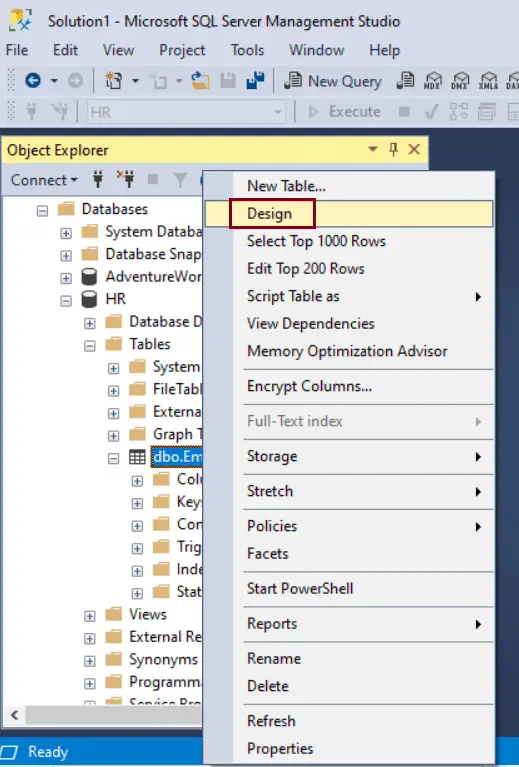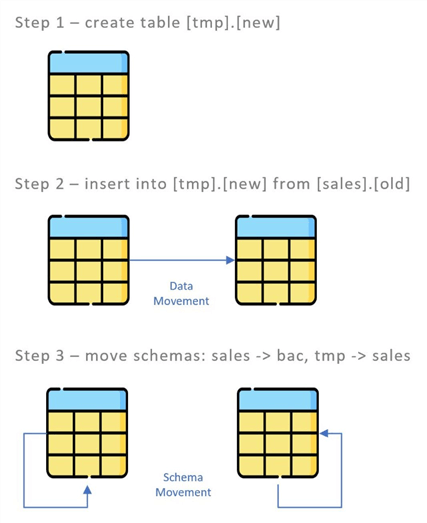
It is possible to delete and add a column of the same name in the same ALTER TABLE statement, however any data in the column is lost in the process. Columns with indexes and table constraints cant be dropped. The statement below deletes the column FullName and adds the column LastName, but only if the LastName column doesn't already exist: DROP COLUMN IF EXISTS : This form drops a column from a table. The ADD keyword requires the same combination of column name, data type and possibly dimensions, and extended column definition information as the CREATE TABLE statement when defining new columns. The DROP keyword requires only the name of the column to be deleted. In addition, the IF EXISTS and IF NOT EXISTS clauses can be used with the ADD, REDEFINE, and DROP keywords to allow for action on columns only if they do or do not exist. DBISAM's REDEFINE keyword removes this problem. This is what is sometimes required with other database engines and can result in loss of data. Indexes and table constraints involving the column will be automatically dropped as well. There are several subforms: This form adds a new column to the table using the same syntax as CREATE TABLE. Second, you put the new column and its definition. ALTER TABLE changes the definition of an existing table.

It is possible to delete one column and add another in the same ALTER TABLE statement as well as redefine an existing column without having to first drop the column and then re-add the same column name. Introduction to MySQL ADD COLUMN statement First, you specify the table name after the ALTER TABLE clause. Use the ALTER TABLE statement to alter the structure of an existing table. The allow_primaryįlag indicates if it is allowed to cancel the allocation of a primary shard.The SQL ALTER TABLE statement is used to restructure a table.Ĭolumn_name data type The new column may take any of the forms permissible in a CREATE TABLE statement, with the following. The column-def rule defines the characteristics of the new column. The new column is always appended to the end of the list of existing columns. Shard_id of a table_ident on a given node. The ADD COLUMN syntax is used to add a new column to an existing table. This cancels the allocation or recovery of a If it is not provided or set to false, the command will Key points of SQL alter table add column statement Using the ALTER TABLE statement to add columns to a table automatically adds those columns to the end of the. To add a column in a table, use the following syntax: ALTER TABLE tablename. The ALTER TABLE statement is also used to add and drop various constraints on an existing table. The parameter accept_data_loss needs to be set to true in order for The ALTER TABLE statement is used to add, delete, or modify columns in an existing table.
Alter table add column how to#
Into the cluster, but if that is not possible due to a permanent systemįailure, it is possible to accept the potential data loss and force promote a Summary: in this tutorial, you will learn how to use the Oracle ALTER TABLE ADD column statement to add one or more columns to a table. I would like to add an column to an already existing table without using legacy SQL. In SQL, the ALTER TABLE command is used to modify the structure of an existing table like adding, deleting, renaming columns, etc. Ideally the node holding the primary copy of the shard would be brought back In caseĪ node holding a primary copy of a shard had a failure and the replica shardsĪre out of sync, the system won’t promote the replica to primaryĪutomatically, as it would result in a silent data loss. PROMOTE REPLICA Force promote a stale replica shard to a primary. ALLOCATE REPLICAĪllows to force allocation of an unassigned replica shard on a specific node. Specify FROM node for the node to move the shard from and Table_ident and a shard_id to identify the shard that receives the

REROUTE supports the following options to start/stop shard allocation: MOVEĪ started shard gets moved from one node to another. The ID or name of a node within the cluster.

Ranges from 0 up to the specified number of Shards


 0 kommentar(er)
0 kommentar(er)
